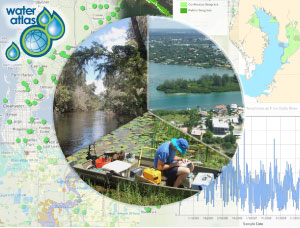 |
||||||||

Water Atlas — Detailed Data for Scientists of All Ages
 From kids to senior scientists, researchers in Tampa Bay depend upon the Water Atlas for the most up-to-date and in-depth data available on ecosystems in the region. Developed by the Florida Center for Design + Research at the University of South Florida in partnership with Hillsborough County, the Water Atlas now includes data from Pinellas, Manatee, Sarasota, Polk, Lake, Orange and Seminole counties as well as the Charlotte Harbor and Tampa Bay estuary programs.
From kids to senior scientists, researchers in Tampa Bay depend upon the Water Atlas for the most up-to-date and in-depth data available on ecosystems in the region. Developed by the Florida Center for Design + Research at the University of South Florida in partnership with Hillsborough County, the Water Atlas now includes data from Pinellas, Manatee, Sarasota, Polk, Lake, Orange and Seminole counties as well as the Charlotte Harbor and Tampa Bay estuary programs.
But even as coverage has expanded, the Water Atlas has become easier to use, particularly for citizen scientists concerned about water quality in lakes and rivers near their homes.
The goal is to allow people from every walk of life to understand the issues facing the region as it continues to grow, notes Bridgette Froeschke, associate in research. A former professor at the University of Tampa, she also serves as the chair of the Gulf of Mexico Fishery Management Council's Ecosystem Scientific and Statistical Committee.
"It's crucial for the public to be able to visualize how creeks, rivers and bays are connected," she said. "The Water Atlas is very visual, but at the same time conservation scientists can drill down to the raw data."
And while an enormous amount of data is contributed by trained scientists, the Water Atlas also includes information collected by citizen-scientists both in reports from organizations like the Lake and River Watch programs and the Frog Listening Network as well as more informal alternatives.
"One of the things we'd like to see more of is interviews with people who remember Tampa Bay before it was developed," Froeschke said. "Each watershed has places for oral histories to be uploaded — that would be a great project for a kid with a smart phone."
Lake Carroll in north Hillsborough County is a good example of the information available on the Water Atlas. Nearly 40,000 data points dating back to 1965 are accessible, including one long-running series from a Lake Watch volunteer (see related story page 8) along with historical narratives.
Some of the data on the Water Atlas dates back to 1907 and some is updated daily. The Tampa Bay Water Atlas contains information on 797 water resources, including 12 bays, 555 lakes, 229 rivers and the Gulf of Mexico. Water quality data comes from over 90 sources through 33 different providers. The Water Atlas also serves as a central location for participating groups to post information on various conservation outreach initiatives, including brochures and information on community events. Other information available on the Water Atlas includes:
- Aerial photography
- Bathymetry (bottom contour) maps
- Boat ramps and parks
- Conservation advice
- Current news about water and ecosystems
- Dynamic maps
- Ecological reports
- Education curricula
- Fishing reports
- Historical photography and maps
- Near real-time data on currents and tides
- Research Reports
- Total Maximum Daily Loads (TMDLs)
- Water levels, flows and rainfall
- Water quality data, dating back decades in some cases
As a statistician with an interest in fisheries, Froeshke hopes to expand the Water Atlas to cover animals as well as ecosystems. For instance, fish need specific habitats to thrive but the complex relationships are not always understood and restoration initiatives don't necessarily incorporate the needs of individual species. "I think there's a need for that kind of information across the Gulf of Mexico," she said.
Over time, Foreschke's goal is to help students and citizens develop the critical thinking skills they'll need to balance competing objectives as the region continues to grow. "The Atlas continues to grow and the data we collect expands every day. It's going to be even more important to have that information easily accessible as we go forward."
